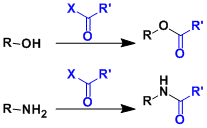General Characteristics -The acylation of aromatic rings using acyl halides or acid anhydrides mediated by Lewis acids is called the Friedel-Crafts acylation. Arenes substituted with electron ...
Posts by Category: Reactions
Vilsmeier-Haack Reaction
General Characteristics The Vilsmeier-Haack reaction is a common method to introduce a formyl group into electron rich aromatic compounds. It is also applicable to electron rich alkenes. The ...
Williamson Ether Synthesis
General Characteristics -The synthesis of unsymmetrical ethers by SN2 displacement of alkyl halides by alkoxides is called the Williamson ether synthesis. The reaction works best when the R group is ...
Curtius Rearrangement
General Characteristics -Upon heating, acyl azides undergo rearrangement to give isocyanates with the loss of N2. In the presence of water, the isocyanates are immediately hydrolyzed to give amines ...
Acyl Protective Groups
General Characteristics -Acyl groups are generally stable under acidic and oxidative conditions and deprotected under reductive (DIBAL, LAH, etc.) and basic (NaOH, K2CO3/MeOH etc.) conditions. ...
Mannich Reaction
General Characteristics -The Mannich reaction is a classic example of three-component condensation reactions. -Under acidic conditions, an amine and an aldehyde condense to form an iminium ion, which ...
Cross Aldol Reaction
General Characteristics -In cross aldol reactions, the donor carbonyl compound is deprotonated completely by a strong base like LDA to preform its metal enolate, which prevents self-condensation upon ...
Buchwald-Hartwig Cross Coupling Reaction
General Characteristics -The palladium-catalyzed cross coupling between aryl halides/triflates and amines/alkoxides is known as the Buchwald-Hartwig reaction. The use of bidentate ligands (e.g. dppf, ...
TPAP (Ley-Griffith) Oxidation
General Characteristics The oxidation of alcohols to aldehydes or ketones can be catalyzed by TPAP (nPr4N+RuO4–; TetraPropylAmmonium Perruthenate) which is air- and moisture-tolerant and also ...
Michael Addition
General Characteristics The Michael reaction originally meant the 1,4-addition (conjugate addition) of simple anionic carbons to the electron poor double bonds conjugated to carbonyl groups. Today’s ...










